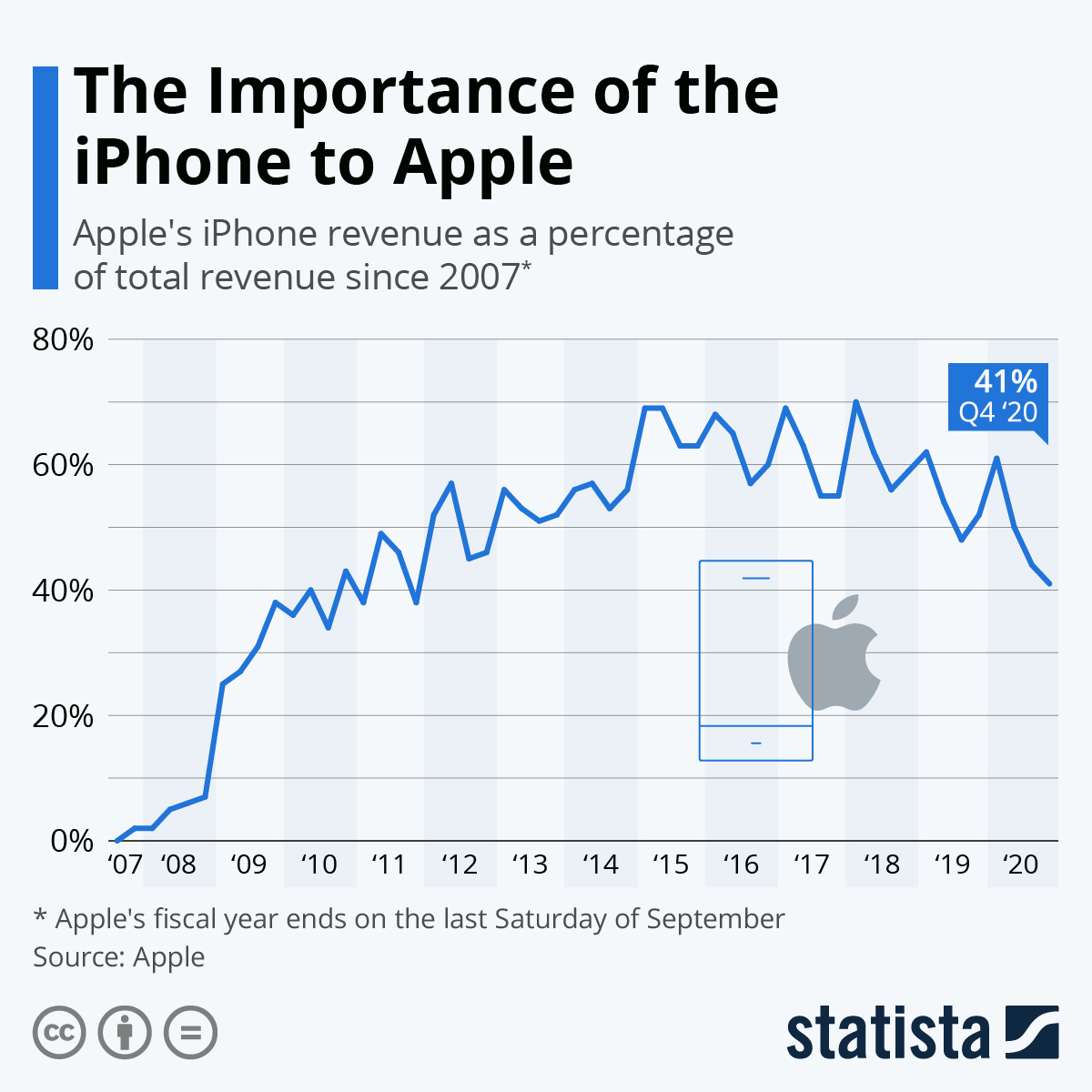Will iPhone's Become Obsolete?
February 11, 2022
January 9th 2007 was the day the mobile phone transformed forever. This was the day that Steve Jobs unveiled
the first ever iPhone. At the time, it was one of the first ever handheld devices to combine a multimedia
player, telephone, and internet browsing capability on a touchscreen display. Now, in 2022, the iPhone has
certainly come such a long way since its launch. Specifically, in 2021, Apple reached a market cap of $3
trillion and generated $365.8 billion in revenue. In fact, the iPhone made up 52% of this revenue coming in
at a whopping $191.1 billion. Apple’s iPhone must be doing something right for it to be this successful.
Let's examine that in this post.

Figure 1: iPhone revenue as a percentage of Apple's total revenue
When the iPhone first released, it did not have many of the functions the competitor phones already had. The
iPhone did not contain GPS, video recording, 3G connection, and a superior camera while the others did.
Although the phone lacked many features, it was nonetheless revolutionary. It introduced a new touch-based
interface that eliminated the physical keyboard. This allowed the phone to have the biggest screen size on
the market. Thus, the phone was highly functional and produced a rich mobile internet browsing experience
never seen before. With a hit phone, Apple had to ensure they did not lose the spotlight. They continued to
develop the product to meet the consumers needs. The most imminent example of this was the introduction of
the App Store. 3rd party developers wanted to have a shot at making applications for the phone and this is
when things started to take off. Downloading applications that other users made put a whole new experience
in the hands of consumers. With the ability for anyone to create applications, the iPhone had everything a
user could have imagined. From mobile banking apps to social media apps, there are now 2 million apps on the
Apple Store that can be downloaded. The larger mobile interface combined with the abundance of apps that
users could use caused the iPhone's popularity to grow exponentially and established a customer base that
buys any phone that they release. As a matter of fact, there is an estimate of 1 billion people in the world
who own and use an iPhone, myself included. That is, 13% of the world’s population uses an iPhone. This just
shows that the phone appeals to the general public and fits everyone’s needs.
Although the iPhone is a household name and the product is continuing to generate generous amounts of
revenue every year, there are some improvements that need to be made to ensure its growth does not slow
down. First off, Apple has to go back to its roots and create more innovative phones. In the past 2 years,
we have seen through the iPhone 11, 12, and 13 that the phones have very few changs. The main highlights
have been upgrades to the camera and some internal specs. Personally, I found myself debating whether to get
the iPhone 12 or 13, and after comparing what has changed, it didn’t make sense to pay an extra $250 just
for cinematic mode on the camera and a slightly better bionic chip. Looking at iPhone’s competitors, they
are constantly rolling out new phones that include innovative hardware that are attracting new customers.
For instance, Samsung and Huawei unveiled the first modern folding phones in 2019. These phones have
flexible screens that allow users to compact the technology and fit it in very small places, but also allow
the user to open it up and have a large touchscreen display. In this case, these companies found success in
going back to their roots and modernizing the original flip phone. Apple on the other hand has only released
a concept image of a folding phone. They are undoubtedly falling behind in this aspect of technology since
competitors are already testing and releasing flip phones to the public. Moreover, it seems that Apple’s
operating system, IOS, continues to lag behind its competitors as well. This can be seen with Apple’s new
feature of ‘Live Text’. This feature allows images to recognize text and the user can copy and paste that
text to wherever they want. Although this feature seems brilliant, Android phones have had a similar feature
well before Apple came up with the idea. Android’s Google Lens released in October of 2017 while Apple’s
Live Text released in September of 2021. This means that Google has been testing out and developing this
technology for 4 years while Apple just released its first version of it.
As seen, Apple is no longer being the innovator when it comes to phones. Rather, they wait until a new
feature is well tested by their competitors so that they can perfect it and add it onto their own phones
years later. On one hand this is a good thing as iPhones are refined and do not contain many issues during
its initial release of a feature, however, if Apple waits to jump on the next big innovation in the phone
industry, some of their customers may go to competitor phones. Samsung, Huawei, and Google Pixel users will
stick with what they’re using, while some iPhone users will be tempted to try a new innovative phone that
Apple does not currently have something similar to in their arsenal. This could lead to the start of
the iPhone's downfall.



